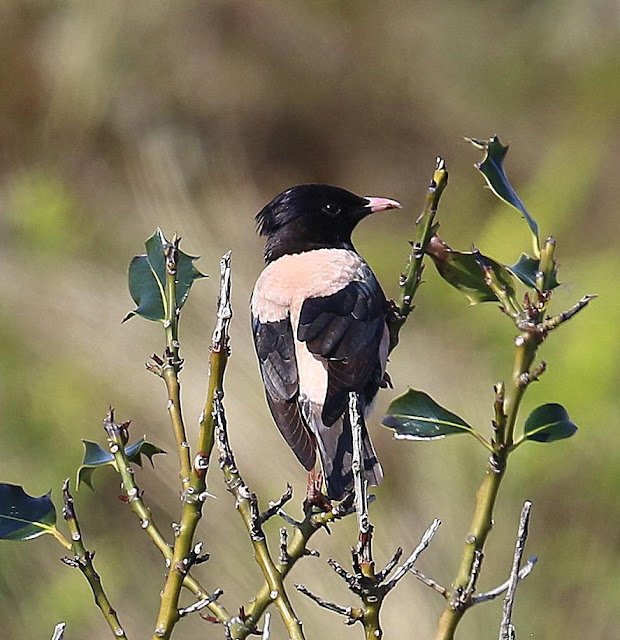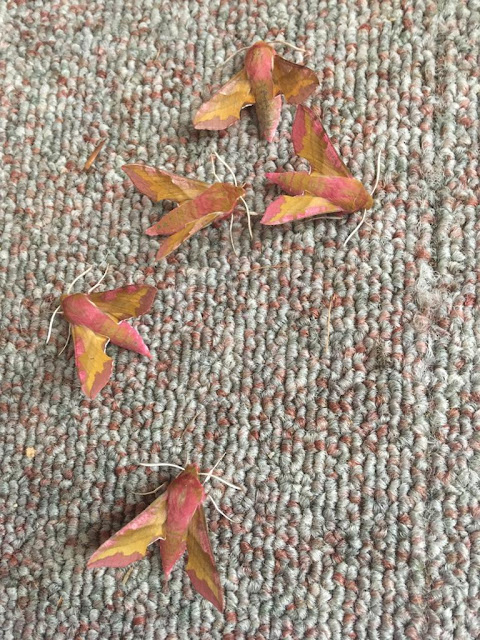Butterflies remained a nice feature in the South Dunes at the start of the month, with Brown Argus and Green Hairstreak continuing to show well, and Painted Ladies, Wall, Holly Blue, Common Blue etc all being seen.
It wasn't until we started processing our photos that we noticed the snazzy orange headlights of the Green Hairstreak!
On the evening of the 2nd Sean heard a Grasshopper Warbler reeling in rough grassland and reeds at the north end of the patch, and managed a couple of record shots.
On the morning of the 3rd another of our regular visiting birders, Drew, found a Marsh Warbler in a small group of willows along the dune ridge at the north end of the patch, and managed to obtain this recording of its song. It was later seen by another of our regular visitors, Mick S, but it had fallen silent or moved on by early afternoon and none of the locals managed to connect with it in time.
In the mid afternoon Barry saw a Rose-coloured Starling fly in from the east through the dunes and go down in the village painfully close to Sean and Peter's gardens. Quite a few of us managed to see it over the next hour or so but Sean was in London being continually gripped off by a stream of delighted WhatsApp messages.
Things got worse for Sean when later in the afternoon one of the tern wardens, Will B, found a splendid male Red-backed Shrike in the North Dunes very close to the village. Mick took this picture of it in flight.
By now Sean was driving home from London, trying hard to ignore the continual pings on his phone and not to get done for speeding. He arrived home in the early evening and managed to connect with the Shrike at the end of his road quite quickly.

With no sign of the Starling and not much daylight left Sean decided to cycle up to the north end in the hope that maybe the Marsh Warbler might still be around and might even decide to sing, since the species is known for its nightime repertoire. Amazingly, after only about a 15 minute wait, he was rewarded: it began to sing, initially quite quietly but gathering strength over the next few minutes, in the tangle of brambles and weedy scrub on the west side of the path a little to the north of where Drew had found it. Although he never got a view better than a mainly hidden Acro moving through the weeds, he did manage to record this snatch on his phone. It sang for about 10 minutes fairly continuously, then subsided into the odd short burst, before stopping completely. On his cycle ride back he also heard the Grasshopper Warbler again singing in the same spot as yesterday.
On the 4th Sean had poor views of another Acro in the South Dunes, but after a little wait it chuntered into song and proved itself to be a Reed Warbler. On the same day Colin had two Canada Geese flying north over the North Dunes, and Sean saw a Red Kite over the north woods. The next day this Barn Owl was hunting in the fields along the concrete track in the early evening.
After such a terrible start to the year, the Collective moth-ers were getting more success, and Patrick had this very nice Light Brocade on the night of the 5th/6th.
Good diurnal moths also began to put in appearances for Tim, who had this Broad-bordered Bee Hawkmoth on his allotment on the 7th.
Also on the 7th visiting birders found a dark Great Skua on the beach. There was some debate about its plumage and size, and hence identity, but since none of the resident birders saw it we are unable to comment 😁. On the same day another (or perhaps the same) Rose-coloured Starling was seen in the South Dunes. Sean was yet again away from the village and beginning to despair, but this time there was a happy ending for him!
Here are a couple of nicer record shots of the bird from Patrick.
The starling was still in the valley the next day and Tim wheeled his big gun out for this portrait.
Meanwhile after a very poor showing last year our little patch of parish Bee Orchids was performing very well with lots and lots of flower heads. Here's one Mick photographed.
With the improved weather in the second week of June some attention turned to dragonflies, and quite a lot of Red-veined Darters were observed in the north dunes, along with the more usual commoner species, and also a Norfolk Hawker.
The North Dunes pools held a lot of life during this period, and it was very pleasurable just to sit by them and see what popped up.
The Lepidoptera action continued too, and Ted attracted this impressive herd of Small Elephants to his trap overnight on the 11th/12th.
After a few days' absence the (or a) Rose-coloured Starling reappeared in the North Dunes on the 12th, found by another regular visitor, Stuart W, and was eventually tracked down to the coastwatch/carpark/huts area, where we were able to follow the stage directions!
The Starling's reappearance was potentially very good news for Colin who was on his way back from a poorly-timed holiday in the Yorkshire Dales. Tragically for him he got stuck in a four hour traffic jam and although he looked hard for it when he finally got home, it had once again done a bunk. It did reappear in the South Dunes very early the next day for Barry, but sadly not for Colin.
So were there one, two, or three different individual Rosy Starlings? It seems to us that at least two different birds were involved in the sightings between the 3rd and the 13th, but we haven't studied all the photos properly so if anyone has any opinions on this please let us know!
On the 14th Sean saw yet another potentially exciting Acro in the South Dunes which duly turned into yet another Reed Warbler. Also around this time Tiger Craneflies were becoming quite evident in the valley, although focusing a camera on these impressive little beasts instead of on the leaves behind them proved to be a tough challenge!
Last Autumn Sean had sowed a patch of his back garden with meadow wildflower and cornfield annual seeds, and the kinder weather of June meant that it was finally starting to bloom.
One of the pleasure of this was the variety of Hoverflies it was now attracting.
On the 16th a male Bullfinch in the North Dunes was an unexpected find for Sean, but it wouldn't sit nicely for its picture!
In a major coup for his yearlist, Maynard returned from holiday in Scotland on the 17th, had a cycle round the concrete track, and put up a Bittern from one of the dykes!
On the 20th large numbers of Swifts and hirundines were feeding over the fields to the west of the village, probably because cold northeasterly airstreams (again!) had pushed insects inland. This time last year saw the start of a really phenomenal movement of non-breeding Swifts down the coast, but no such movement happened this June. On the 21st a Cuckoo was calling on farmland to the west too.
The 22nd was a red letter day for two Collective members! Just after 3pm Sean was in his garden admiring hoverflies on his mini-meadow, and Pete was walking back from the allotments and had just reached the east end of Low Road, when they both heard unusual whiffling chittery calls coming from the north-west. Both had been hoping for Bee-eaters and this was the first thought of both, but the sound wasn't right, it was more tern-like or wader-like. Suddenly the birds appeared, elegant, long-winged waders, chattering excitedly. It was 3 Black-tailed Godwits, a full-on patch tick for Sean and a parish tick for Pete (who had seen two from the concrete track - on the patch but not in the parish - in February).
Tim's allotment continued to repay his flower-planting strategy and produced a Hummingbird Hawkmoth on the 23rd - they have been scarce so far this year.
The weather towards the end of the month slipped back to being intermittently colder again, and for various individual reasons the Collective members did not get out in the field as much as usual. Despite this, Curlews started to be seen with some regularity, and Pat kept us updated with sightings from his house of the Peregrine which remained around the Church off and on throughout the month.
The Little Terns finally started settling, with around 400 birds on the beach and good numbers of nests, but still having to endure a lot of cold and rainy weather. On the 27th Mick found a Black Tern on the beach too!
So as we go into July it's fingers crossed all round that the Little Terns can still have a successful breeding season despite the awful Spring, and we all applaud the efforts of Lottie, Will and the rest of the tern wardens and volunteers in helping these beautiful and rare birds which choose to spend their summer on our beach before winging their way back to Africa. What a privilege for us!
At the end of June the total number of bird species we have seen on the patch this year has reached 178, and Pat and Maynard are neck and neck in the race! But of course, we are a collective, and we don't compete with each other at all. Honestly...
See you next month and happy patch birding everyone!







































